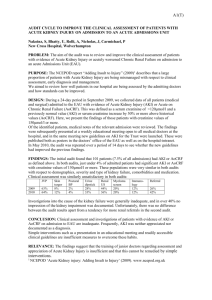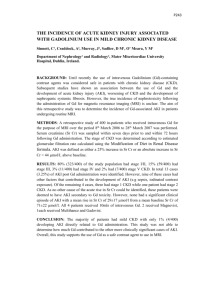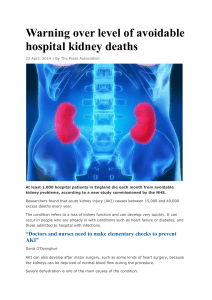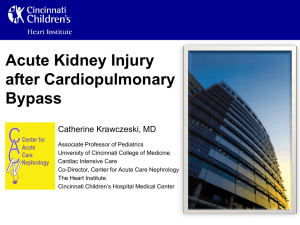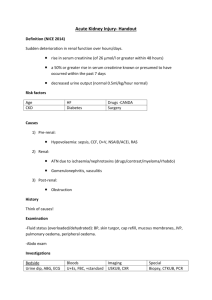Acute kidney injury in critically ill children: incidence, diagnosis
advertisement
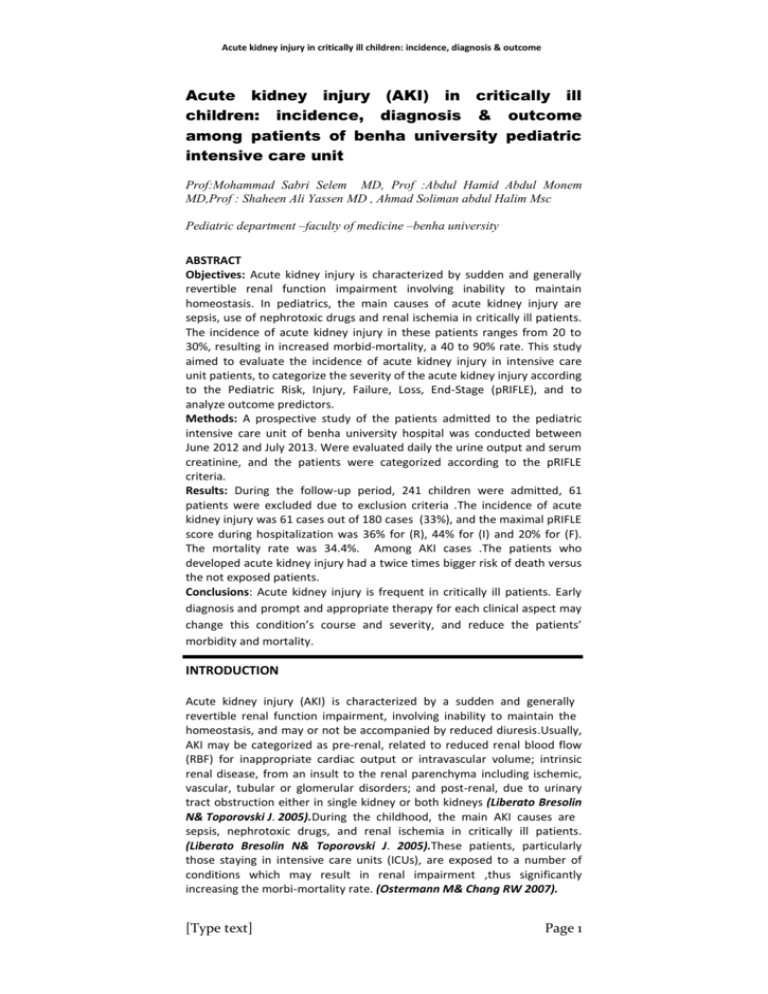
Acute kidney injury in critically ill children: incidence, diagnosis & outcome Acute kidney injury (AKI) in critically ill children: incidence, diagnosis & outcome among patients of benha university pediatric intensive care unit Prof:Mohammad Sabri Selem MD, Prof :Abdul Hamid Abdul Monem MD,Prof : Shaheen Ali Yassen MD , Ahmad Soliman abdul Halim Msc Pediatric department –faculty of medicine –benha university ABSTRACT Objectives: Acute kidney injury is characterized by sudden and generally revertible renal function impairment involving inability to maintain homeostasis. In pediatrics, the main causes of acute kidney injury are sepsis, use of nephrotoxic drugs and renal ischemia in critically ill patients. The incidence of acute kidney injury in these patients ranges from 20 to 30%, resulting in increased morbid-mortality, a 40 to 90% rate. This study aimed to evaluate the incidence of acute kidney injury in intensive care unit patients, to categorize the severity of the acute kidney injury according to the Pediatric Risk, Injury, Failure, Loss, End-Stage (pRIFLE), and to analyze outcome predictors. Methods: A prospective study of the patients admitted to the pediatric intensive care unit of benha university hospital was conducted between June 2012 and July 2013. Were evaluated daily the urine output and serum creatinine, and the patients were categorized according to the pRIFLE criteria. Results: During the follow-up period, 241 children were admitted, 61 patients were excluded due to exclusion criteria .The incidence of acute kidney injury was 61 cases out of 180 cases (33%), and the maximal pRIFLE score during hospitalization was 36% for (R), 44% for (I) and 20% for (F). The mortality rate was 34.4%. Among AKI cases .The patients who developed acute kidney injury had a twice times bigger risk of death versus the not exposed patients. Conclusions: Acute kidney injury is frequent in critically ill patients. Early diagnosis and prompt and appropriate therapy for each clinical aspect may change this condition’s course and severity, and reduce the patients’ morbidity and mortality. INTRODUCTION Acute kidney injury (AKI) is characterized by a sudden and generally revertible renal function impairment, involving inability to maintain the homeostasis, and may or not be accompanied by reduced diuresis.Usually, AKI may be categorized as pre-renal, related to reduced renal blood flow (RBF) for inappropriate cardiac output or intravascular volume; intrinsic renal disease, from an insult to the renal parenchyma including ischemic, vascular, tubular or glomerular disorders; and post-renal, due to urinary tract obstruction either in single kidney or both kidneys (Liberato Bresolin N& Toporovski J. 2005).During the childhood, the main AKI causes are sepsis, nephrotoxic drugs, and renal ischemia in critically ill patients. (Liberato Bresolin N& Toporovski J. 2005).These patients, particularly those staying in intensive care units (ICUs), are exposed to a number of conditions which may result in renal impairment ,thus significantly increasing the morbi-mortality rate. (Ostermann M& Chang RW 2007). [Type text] Page 1 Acute kidney injury in critically ill children: incidence, diagnosis & outcome Among the main causes we should men-tion: hypovolemia leading to hypoperfusion and consequent hypoxia; inflammatory and thrombotic events caused by sepsis; systemic inflammation from trauma, major surgeries, extracorporeal circulation ;use of vasodilator drugs such as phosphodiesterase inhibitors, sedatives, epidural blockade; vasopressors; and use of nephrotoxic drugs as aminoglycosides, amphotericin B, radiological contrasts, and drugs interfering with the renal hemodynamics such as angiotensin converting enzyme inhibitors and angiotensin II receptor blockers(Liberato Bresolin N& Toporovski J. 2005).Sepsis, and specially the septic shock, is one of the main causes of AKI. AKI prevalence is sepsis ranges from 9% to 40%, involves poor prognosis, and is as-sociated with a 70% mortality rate. (Schrier RW& Wang W. 2004);Among critically ill renal impaired patients, about 6% may need renal replacement therapy (RRT), with a mortality rate increased by 50 to 80%, particularly associated with sepsis, septic shock, and multiple or-gan and systems dysfunction MODS (VA&NIH 2009). The AKI diagnosis methods include: clinical evaluation of the urinary output and laboratory tests as urinalysis, blood urea nitrogen, and creatinine, however with low sensitivity and specificity.( Bresolin N et al.,2009) Biomarkers for early AKI detection are currently under investigation ,among them neutrophil gelatinase associated lipocalin (NGAL), cystatin C, interleukin 18, and kidney injury molecule-1 (KIM1).(20)Although these markers have good sensitivity and specificity, they are not routinely used due to their low availability and high costs (Nguyen MT&Devarajan P. 2008). In this context, the Acute Dialysis Quality Initiative(ADQI), which involves the participation of nephrologists and intensivists, held in 2002 in the city of Vicenza the Second International Consensus Conference of the ADQI. (Belloo R, et al. 2004) where adult AKI diagnosis criteria were proposed and decided, and detailed published in 2004 with the name RIFLE criteria. These are currently under scientific community evaluation.The RIFLE criteria define three grades of increasing AKI severity (R – Risk of renal dysfunction; I – Injury of the kidney; F – Failure of kidney function )and two outcome variables (L - Loss of kidney function and E - End-stage kidney disease). For the first three categories, the RIFLE criteria aimed to standardize AKI definition by patients’ stratification according to serum creatinine and urinary output changes from baseline. (Belloo R, et al. 2004) Recently, Akcan-Arikan et al. provided a pediatric patients-modified RIFLE version (pRIFLE), based on a 12 months single center study where 150 critically ill children were prospectively analyzed (Akcan-Arikan Aet al.,2007)..The proposed pRIFLE criteria are based on the estimated creatinine clearance (ECC) calculated by means of the Schwartz formula (Schwartz GJ,et al.,1987) or on the urinary output reduction, in a body weight per hour basis, as detailed on Table 1.This study aimed to evaluate the incidence of AKI in ICU patients, and to categorize the AKI severity according to the new pRIFLE diagnosis criteria, quantify and analyze the AKI and to evaluate the associated prognostic factors Table (1 ): pediatric RIFLE classification system RIFLE Serum creatnine Urine out out Risk (R) Serum creatinine increase to 1.5 fold or GFR decreased >25% from baseline Serum creatinine increase to 2 fold or GFR decreased >50% from baseline Serum creatinine increase to 3 fold or GFR decreased >75% from baseline, or Serum creatinine(> 4mg/dl) <0.5ml/kg/for 6 hours Injury (I) Failure (F) <0.5ml/kg/for 12 hours anuria for 12 hours (Bellemo et al,.2004) [Type text] Page 2 Acute kidney injury in critically ill children: incidence, diagnosis & outcome Aim of the work To evaluate incidence of AKI according to pRIFLE criteria, associated risk factor and outcome in the PICU. Patients & Methods All consecutive admissions to the benha university hospital PICU (a twelve beds pediatric ICU) were included in prospective study, from July 2012 to last of June 2013 this study was approved by the Institution’s Ethics Committee. This study was explained to the patients’ parents or legal representatives, before they were asked to sign the In-formed Consent Form. The exclusion criteria were: Less than one month of age, More than 18 years of age, Less than 24 hours stay in PICU, Brain death at admission, Chronic kidney disease (GFR is less than 60ml/min/1.73m , for more than 3 months) & End stage renal disease on regular hemodiaysis. The included patients were followed from admission to discharge or death on daily biases for clinical, laboratory parameters, certain risk factors and outcome according to arranged protocol with consideration of exclusion criteria, each readmission after more than 24 hours after discharge is considered as a new admission. The cases were divided in to two major groups. Group (A): PICU cases with AKI (Acute kidney injury), and this group were subdivided into 3 subgroups according to RIFLE classification(Risk group , injury group and failure group).Group (B): PICU case without AKI (Acute kidney injury).For kidney injury degree (pRIFLE) (Akcan-Arikan Aet al.,2007) categorization, were analyzed daily: depending on serum creatinine level, and the estimated creatinine clearance was calculated according to the Schwartz formula.(Schwartz GJ,et al.,1987) The patients admitted with missing baseline renal function data had the normal clearance value of 100 mL/1.73 m/24 h considered as reference, as proposed by Akcan-Arikan et al (Akcan-Arikan Aet al.,2007). The data collected were statistically analyzed. The quantitative variables were expressed as means and standard deviations, and median values .The categorical variables were described by their absolute (n) and relative (%) frequencies. The association between the different variables was analyzed by appropriate hypothesis testing )Pearson’s Chi-square, exact Fisher’s, Mann-Whitney’s, and Kruskall-Wallis tests( The relative risks )RR( for patients’ complications & outcomes for either with or without acute renal failure were calculated, as well as their respective 95% Confidence Intervals )95%CI(. P values ≤ 0.05 were considered significant (Kirkwood B.1988) .The analysis were per-formed using the SPSS version 16 . RESULTS During this 12 months period 241 children were admitted to the PICU, being 61 of them excluded for presence of exclusion criteria Of the180 children in this study, (60.5%) were male ,the age group range was from one month up to 14 years . of 180 patients 61 patients were AKI (33%) according to pRIFLE . regarding to diagnosis admission the most common admission diagnosis was infection 51.1% then DKA (8.3 )%, neurological conditions(7.8)% & cardiac failure(7.8)%.The comparison [Type text] Page 3 Acute kidney injury in critically ill children: incidence, diagnosis & outcome between group (A) & (B) regarding to risk factors which may predispose to acute kidney injury (AKI). The group (A) was significantly associated with mechanical ventilation, infection, nephrotoxic drugs, shock, haematooncological pathologies, and intrinsic renal disease see table ()Regarding duration of PICU admission duration, in the Group (A) the Median age value of duration of PICU admission was 7days while in Group (B) was 5days.There was significant difference between the group A & B regarding admission duration in days as group A was associated with longer PICU admission (P<0.05) . Regarding mortality in group A Survived /died cases was ( 65.6 / 34.4 )% and in group (B) was ( 84.8/15.2 )% with significant difference between the two groups as group (A) was associated with higer mortality with Relative risk (RR) was 1.9. Table (2): statistical comparison between groups(A)&(B)regarding risk factor Item Group A No = 61 Group B No = 119 Chisquare P value No % No % Mechanical ventilation Associated Organ dysfunction Shock 24 39.3 20 16.8 11 <0.01 21 34.4 18 15.1 8.8 <0.01 14 22.9 9 7.5 8.5 <0.01 Bleeding 8 13.1 1 0. 8 12.7 0.00 Nephrotoxins 17 27.8 14 11.7 7.3 <0.01 Infection 30 49.1 29 24.3 11.2 <0.01 Oncohaematological pathology on admission Intrinsic renal disease on admission Survived 3 4.9 0 0 2.4 <0.05 5 8.2 1 0.8 2.6 <0.05 40 65.6 101 84.8 Died 21 34.4 18 15.2 10.1 > 0.01 In this study the different AKI classes incidences at maximal RIFLE were as the followings: Class (R) was 22 cases out of 61 (36%).Class (I) was 27 cases out of 61 (44%).Class (F) was 12 cases out of 61 (20%).In this study when the three classes of AKI were compared regarding the selected risk factors for AKI ( mechanical ventilation , shock , nephrotoxins and sepsis) to obtain data which refer to if these risk factors affect the severity of AKI level or not , in this study when the three classes were compared to each other regarding these risk factors we found statistically significant difference regarding sepsis , haemto –oncological pathologies and intrinis [Type text] Page 4 Acute kidney injury in critically ill children: incidence, diagnosis & outcome renal disease and no statistical significant difference regarding nephrotoxins & shock Among AKI classes. AKI onset on admission Class (R) cases of AKI onset on admission were (1) case out of 22 (4.5%).Class (I) were (9) cases out of 27 (33.3%).Class (F) were (12) cases out of 12 (100%).With comparison of these subgroups, there was significant difference among the AKI classes regarding AKI onset on admission (p< 0.05), as class (F) was significantly associated with larger number of cases of AKI onset on admission than in other classes, and this reveals that the sever AKI cases were associated with early onset of AKI. AKI etiology (primary versus secondary causes) among AKI classes Class )R( the primary / secondary cause’s ratio was )3/19( (13.6/86.4)%.Class (I)was (1/26) (4/96)% and Class (F) was (8/4) (67/33)%. With comparison of the AKI classes regarding the primary to secondary etiology we found a highly statistically significant difference as classes (R)& (I) were a highly significantly associated with secondary AKI in comparison to class (F) which was significantly associated to primary AKI , this refer to the the vast majorty of AKI etiology in the PICU were related to secondary causes more that primary causes . complicated cases among AKI classes. The complicated cases distribution among AKI classes. Class (R) the complicated cases were (6) out of 22, (27.3%),Class (I): were (17) out of 27, (63%) and Class (F) were (11) out of 12, (91.7%).the class (F) & (I) were Highly significantly associated with larger number of complicated cases than class (R) (P<0.01). Therapy mode among AKI classes ,Class (R) conservative/ RRT ratio was (22/0) (100% / 0%).Class (I) was (27/0) (100% / 0%) &Class (F) was (6/6) (50% / 50%). In comparison of AKI classes regarding therapy, the class (F) was absolute significantly associated with cases which received replacement therapy in comparison with classes (R) or (I). For reversal of renal function (prognosis) with 1st 48 hours of admission Class (R) cases that had early reversal of renal function were (19) cases out of 22 (86.3%).Class (I) were (18) cases out of 27 (66.6%).Class (F) were (2) cases out of 12 (16%). In comparison of three classes of AKI we found that class (R) & (I) were significantly associated with improved renal function with 1st 48 hours of admission in comparison to class (F) with p value of (0.00) which refer to absolute significant difference Regarding survival among AKI classes Class (R): survived / died cases ratio was (21/1) - (95.4/4.6)% .Class (I):was (20/7) -(74/26)%.Class (F)was (5/7) - (41.7/58.3)%.With the comparison of the three classes regarding survived / died ratio and the comparison revealed statistically significant difference among the three classes as the class (F) had significant larger number of died cases than the other classes. [Type text] Page 5 Acute kidney injury in critically ill children: incidence, diagnosis & outcome Table (3): statistical comparison among AKI classes regarding riskfactors , etiology , complications , prognosis , therapy & outcome Item MV Risk (R) NO=22 No % 5 22.7 Injury (I) NO=27 No % 13 48 Failure (F) NO=1K2 No % 6 50 p >0.05 Shock 3 13.6 8 30 3 25 >0.05 Organ dysfunction 7 32 8 30 6 50 >0.05 Coagulopathy 0 0 5 18 3 25 <0.05* Nephrotoxins 5 23 9 33 3 25 >0.05 Sepsis 6 27 14 52 10 83 Oncohaematologic al Intrinsic renal 0 0 0 0 3 25 <0.01* * 0.00 0 0 0 0 5 41.6 0.00 Primary AKI 3 13.6 1 4 8 67 Secondary AKI 19 86.4 26 96 4 33 Complicated AKI 0 0 3 11 11 91.7 <0.01 Improvement with conservative therapy <0.01 19 86.3 18 66.6 2 16 0.00 Conservative 22 100 27 100 6 50 RRT 0 0 0 0 6 50 Survived 21 95.4 20 74 5 41.7 Died 1 4.6 7 26 7 58.3 0.00 [Type text] <0.05 Page 6 Acute kidney injury in critically ill children: incidence, diagnosis & outcome Complicated cases among AKI classes Fig (1): AKI classes& complications 91.70% Failure 11% 0% Injury Risk Therapy among various AKI classes Consevative Renal replacement therapy 100% 100% 50% 50% 0% 0% Fig (2): AKI classes& therapy Risk (R ) Injury (I) Failure ( F) Improvement in the 1st 48 hours of AKI onset with consevative treatment 86.30% Fig (3): AKI classes& prognosis 66.60% 16% Risk (R ) Injury (I) Failure ( F) survival & AKI classes survived 95.40% 4.60% Risk [Type text] 74% 26% Injury died Fig (4): AKI classes& survival 58.30% 41.70% Failure Page 7 Acute kidney injury in critically ill children: incidence, diagnosis & outcome Discussion AKI has a known catastrophic impact on critically ill patients. It is common among them, and its cause is mostly multifactor. AKI may progress to renal failure, preventing the kidneys to play their most important role, homeostasis. During the study were admitted to the PICU The incidence of AKI in this study was (33%), which 61 cases out of 180 cases admitted to the PICU admission As regard to the incidence of AKI in various studies, the incidence was variable as (Hoste EA et al., 2006) reported incidence of 67.2%.while (Ostermann M &Chang RW 2007) reported AKI incidence of 35.8% and (Bagshaw SM et al., 2008) reported incidence of 36.1%, This variation can be explained by specific epidemiological characteristics according to the area of study. Regarding duration of PICU admission duration, There was significant difference between the group A & B regarding admission duration in days as group A was associated with longer PICU admission (P<0.05) .This agree with (Akcan-Arikan A et al.,2007) ,(Duzova A et al.,2010) as they reported the AKI cases which diagnosed on basis of RIFLE criteria were associated with longer PICU stay in comparison with non AKI group and it means that AKI cases consume prolonged time in intensive care units and so resources consuming , but (plotz et al .,2008) reported that the was no significant difference between the AKI cases & non AKI cases regarding the admission PICU duration and this was explained by variation of diseases which admitted to PICU which associated with prolonged admission length without presence of AKI . For mortality & survival In this study the group A was highly significantly associated with higher mortality and lower survival (P<0.01) with relative risk (RR) of 1.9 than in group B and this means that the AKI cases were twice times bigger in mortality than that of non AKI cases .This agree with (keina et al., 2010) who reported that the mortality in AKI cases was ten times bigger than that in non AKI cases also (plotz et al .,2008) identified a five times bigger mortality in AKI cases than that in Non AKI cases ,( Hoste EA et al.,2006) identified three times bigger mortality rates in the exposed group, (Ostermann M &Chang RW 2007) identified that AKI patients had a four times bigger mortality versus non-AKI patients. This can be explained by (Prasad& Stuart L, 2009) who mentioned that AKI is associated with a number of life-threatening complications, which increase the mortality rate in these cases, In this study the different AKI classes incidences at maximal RIFLE were as the followings: Class (R) was 22 cases out of 61 (36%).Class (I) was 27 cases out of 61 (44%).Class (F) was 12 cases out of 61 (20%).In this study when the three classes of AKI were compared regarding the AKI level incidence was variable at different studies as (keina et al., 2010) reported That the maximal RIFLE score found during the patients stay was 39.1% for class (R), 39.1% for class ( I ) and 21.8% for class ( F) while (Akcan-Arikan A et al.,2007) found 48.8%, 26% and 25.2%, respectively, and (plotz et al .,2008) reported incidences of 52%, 37% and 11%, respectively .This variability of incidences can be explained by (keina et al., 2010) who reported that the cause of this variability was due to different populations studied, and also by the different ICU characteristics. [Type text] Page 8 Acute kidney injury in critically ill children: incidence, diagnosis & outcome Regarding AKI etiology ,With comparison of the AKI classes regarding the primary to secondary etiology we found a highly statistically significant difference as classes (R)& (I) were a highly significantly associated with secondary AKI in comparison to class (F) which was significantly associated to primary AKI , this refer to the the vast majorty of AKI etiology in the PICU were related to secondary causes more that primary causes .And this agrees with (Paula Dennen et al.,2010) who reported that The cause of AKI in the ICU is frequently develops from a combination of hypovolemia, sepsis, medications, and hemodynamic perturbations. Regarding AKI onset on admission there was significant difference among the AKI classes regarding AKI onset on admission (p< 0.05), as class (F) was significantly associated with larger number of cases of AKI onset on admission than in other classes, and this reveals that the sever AKI cases were associated with early onset of AKI. Regarding AKI onset in the 1st week of admission ,Class (R) cases of the 1st week AKI onset of admission were (20) cases out of 22 (90.9%),Class (I) cases of the 1st week AKI onset of admission were (26) cases out of 27 (96.3%) and Class (F) cases of the 1st week AKI onset of admission were (12) cases out of 12 (100%).With comparison of these subgroups, there was no significant difference among the AKI classes regarding AKI onset on the first week of admission (p > 0.05), and means that the vast majority of AKI cases onset was in the first week of admission and AKI was unlike to develop after first week of admission This agree with (Akcan-Arikan A et al., 2007) who reported that the AKI occurred very early in the PICU course most often within the first week of admission and patients who did not develop AKI with in the first week of admission were very unlikely to develop AKI later .this data support previous pediatric studies demonstrating that children develop their maximum number of organ failure early in the intense care unit (ICU) course. In this study Incidence of RRT versus Conservative was: 55 cases out of 61 (90%) received conservative therapy &6 cases (10%) received renal replacement therapy .This refers to the majority of cases of AKI in the PICU received conservative therapy. These results agree with (keina et al., 2010) who reported that renal replacement therapy was required by 11.6% patients and (Akcan-Arikan A et al., 2007) who reported that 8.9% of patients needed renal replacement therapy Therapy mode among AKI classes In comparison of AKI classes regarding therapy, the class (F) was absolute significantly associated with cases which received replacement therapy in comparison with classes (R) or (I). This agree with (keina et al., 2010) who reported that the vast majority of cases which needed renal replacement therapy were in class (F), representing 40% of this subgroup also (Akcan-Arikan A et al., 2007) found 71% of the class (F) level patients received Renal replacement therapy while (plotz et al .,2008) reported incidence of 14.3% of class F needed replacement therapy . The difference in values and incidences of RRT for Class F in the previous studies can be explained by (keina et al., 2010) who reported that the difference in these studies regarding percentage of RRT in class F in the previous three studies due to lack of specific criteria for RRT indications and probably due to different population characteristics, although all were critically ill patients. [Type text] Page 9 Acute kidney injury in critically ill children: incidence, diagnosis & outcome For reversal of renal function with 1st 48 hours of admission Class (R) cases that had early reversal of renal function In comparison of three classes of AKI we found that class (R) & (I) were significantly associated with improved renal function with 1st 48 hours of admission in comparison to class (F) with p value of (0.00) which refer to absolute significant difference. This agree with (Akcan-Arikan A et al., 2007) who reported that Early reversal of AKI was likely to occur in patients with class R than in those in class I & F. Regarding survival among AKI classes, with the comparison of the three classes regarding survived / died ratio and the comparison revealed statistically significant difference among the three classes as the class (F) had significant larger number of died cases than the other classes. This agrees with (Hoste EA et al.,2006 ) , (Akcan-Arikan A et al., 2007) & (keina et al., 2010) who reported that mortality increased in parallel with the AKI severity groups, which was also identified by other authors .A similar mortality rate was found for AKI R and I levels (14.8%). (keina et al., 2010) also reported that The identification that the level R has increased progression to more severe levels, and high mortality rates in this level similar to level I (more severe), emphasize the relevance of the early diagnosis and therapy. It is thus suggested that early AKI diagnosis will result in improved prognosis and, specially, reduced mortality , Yet patients categorized as level F had a substantially higher mortality rate (60%) versus other AKI levels, showing that the level F represents a severe insult condition, with severe functional impairment and decreased reversibility, nevertheless the best of the therapeutic efforts. Conclusion In this study the incidence of AKI in critically ill patients was high. AKI was directly related to increased mortality, with a twice times bigger risk of death versus patients without AKI.. The time of hospital stay was determinant. It was seen that patients with AKI staying longer. Regarding the AKI-associated prognostic factors, it was identified that INFECTION , BLEEDING , haemato-oncological pathology, intrinsic renal disease on admission lead to more severe AKI, and Dialysis was required more frequently in the patients with more severe AKI. The pRIFLE criteria were shown to be important for early AKI risk patients detection, suggesting that, with its use, earlier diagnosis will imply more careful and less delayed therapy, which in long term will lead to reduction in this disease related morbidity and mortality. References Akcan-Arikan A, Zappitelli M, Loftis LL, et al. (2007): Modified RIFLE criteria in critically ill children with acute kidney injury. Kidney Int 71: 1028– 1035. Bagshaw SM, George C, Dinu I, et al., (2008): A multi-centre evaluation of the RIFLE criteria for early acute kidney injury in critically ill patients. Nephrol Dial Transplant.;23(4):1203-10 Belloo R, Ronco C, Kellum JA, et al. (2004): Acute renal failure – Definition, outcome measures, animal models, fluid therapy and information technology needs: the Second International Consensus Conference of the Acute Dialysis Quality Initiative (ADQI) Group. Crit Care 8: R204–R212. [Type text] Page 10 Acute kidney injury in critically ill children: incidence, diagnosis & outcome Bresolin N, Silva C, Halllal A, et al ( 2009): Prognosis for children with acute kidney injury in intensive care unit. Pediatr Nephrol.;24(3):537-44. Duzova A, Bakkaloglu A, Kalyoncu M et al (2010):Etiology and outcome of acute kidney injury in children. Pediatr Nephrol; 25: 1453–1461 Hoste EA, Clermont G, Kersten A, et al (2006); RIFLE criteria for acute kidney injury are associated with hospital mortality in critically ill patients: a cohort analysis. Crit Care 10: R73. Kenia Machado Souza Freire, Nilzete Liberato Bresolin, Ana Camila Flores Farah, et al (2010): Acute kidney injury in children: incidence and prognostic factors in critically ill patients Rev Bras Ter Intensiva.; 22(2):166-174. Kirkwood B.(1988 ): Essentials of medical statistics. Oxford: Bla-ckwell; Liberato Bresolin N, Toporovski J. (2005): Insuficiência renal agudana sepse. Arch Latinoam Nefrol Pediatr.;5(3):164-72. Nguyen MT & Devarajan P. (2008): Biomarkers for the early de-tection of acute kidney injury. Pediatr Nephrol. ;23(12):2151-7. Ostermann M & Chang RW (2007); Acute kidney injury in the intensive care unit according RIFLE. Crit Care Med. 35(8):1837-43; quiz 1852. Paula Dennen, MD; Ivor S & Douglas, MD; (2010):Robert AndersonAcute kidney injury in the intensive care unit: An update andprimer for the intensivist Crit Care MedVol. 38, No. 1. Plötz FB, Bouma AB, van Wijk JA, et al (2008); Pediatric acute kidney injury in the ICU: an independent evaluation of pRIFLE criteria. Intensive Care Med. 34(9):1713-7. Prasad Devarajan and Stuart L Goldstein (2009): Acute renal failure pediatric nephrology ;363. Schrier RW&Wang W. (2004);Acute renal failure and sepsis. N Eng J Med. 351(2):159-69. Review. Schwartz GJ, Brion LP & Spitzer A. (1987): The use of plasma creati-nine concentration for estimating glomerular filtration rate in infants, children, and adolescents. Pediatr. Clin. NorthAm.;34(3):571-90 VA/NIH(2009); Acute Renal Failure Trial Network, Palevsky PM, Zhang JH, O’Connor TZ, Chertow GM, Crow-ley ST, Choudhury D, el al. Intensity of renal support in critically ill patients with acute kidney injury. N Eng J Med. 2008;359(1):7-20. Erratum in: N Engl J Med .361(24):2391. [Type text] Page 11
